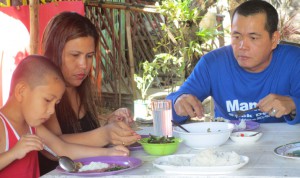Recently, the world turned its attention on food, hunger, and malnutrition.

Rice is the number one commonly consumed food among 90% of children and eaten twice daily, according to the National Nutrition Survey (2008). On the average, a typical Filipino adult can eat as much as 120 kg of rice each year.
The Global Hunger Index 2013, released last week by the International Food Policy Research Institute (IFPRI), shows that global hunger in developing countries has fallen by 39% since 1990.
Of the 842 million hungry people in the world, 553 million live in Asia and the Pacific. In the Philippines and other countries, the level of hunger remains serious, despite progress made in the last two decades. The report tells us that efforts to curb hunger and achieve food security have to continue.
We equate hunger with food. And lack of food is one of the immediate causes of malnutrition. However, there is a growing concern about “hidden hunger” that occurs when people have enough to eat, but not enough micronutrients from that food. It is estimated that more than 2 billion people suffer from hidden hunger.
Our body needs nutrients and energy to survive and we get them primarily from foods that we eat. Hence, choosing the right kinds of food is very important for proper nutrition. Problem is, not everyone has access to nutritious foods.
Many people in Asia, including the Philippines, largely depend on rice for nourishment. They cannot afford or do not have access to a full range of nutritious food such as fruits, vegetables, and foods from animal sources (e.g., meat, dairy products, and eggs). Rice is a very good source of carbohydrates but it lacks other important nutrients. If people consume rice alone, this may not be enough to give a balanced diet.
As a result, lack of iron, zinc, and vitamin A has become prevalent micronutrient deficiencies in rice-consuming countries. The cost of these deficiencies in terms of lives and quality of life lost is enormous, and women and children are most at risk.
Rice is the Filipinos’ staple food. Rice is the number one commonly consumed food among 90 % of children and eaten twice daily from the national nutrition survey in 2008. On the average, a typical Filipino adult can eat as much as 120 kilograms of rice each year.
Have you tried having fried rice for breakfast; rice cake for morning snack; white rice for lunch; suman for afternoon snacks; and arroz caldo for dinner?
If we could make rice healthier, even a small increase in its micronutrient content can make a significant impact on human health. Rice is widely produced and consumed, and for this reason, rice scientists at the International Rice Research Institute (IRRI) and Philippine Rice Research Institute (PhilRice) are developing new types of rice with additional nutrients. These are called healthier rice.
Vitamin A Deficiency
Healthier rice such as Golden Rice is aimed at addressing common micronutrient deficiencies greatly affecting the world’s population, such vitamin A deficiency (VAD). Golden Rice is intended to complement current strategies to reduce VAD.
VAD is very prevalent among children and nursing mothers. The World Health Organization (WHO) estimates that 190 million children and 19 million pregnant women are vitamin A deficient. In Asia, one-third of all preschool children suffer from this deficiency; while in the Philippines alone, 1.7 million children aged 6 months to 5 years, and one out of every ten pregnant women, are vitamin A-deficient.
VAD weakens the immune system and decreases the body’s ability to fight diseases. It also causes night blindness and impaired vision to total blindness if left untreated. In developing countries, as many as 350,000 children go blind each year.
In worst cases, VAD leads to death. Each year, it is estimated that 670,000 children under the age of five die due to complications from VAD.
Interventions
Serious efforts from the government and other sectors have been done to solve this problem. However, VAD continues to adversely affect 10-20% of the population especially in the hardest-to-reach areas.
In search of additional solutions, Golden Rice is being developed to contain beta carotene in its grains which the body converts into vitamin A as needed.
According to the American Journal of Clinical Nutrition, (2009) research so far indicates that eating about one cup a day of Golden Rice could provide half of an adult’s vitamin A needs.
Golden Rice, when available, is expected to be used along with other existing interventions.
Each individual has different energy and nutrient requirements, depending on body size and composition, and level of physical activity. It is important then to supply our body’s nutritional needs by eating the right kinds and amount of foods. Healthier rice could help.




